Copyright 2020 - 2021 irantour.tours all right reserved
Designed by Behsazanhost
Anahita the Sacred Guardian of Streams
Anahita the Sacred Guardian of Streams
By Gilgamesh
When the world, created by the wise lord Ahura Mazda, was still intact and free from Ahriman's malice, the earth was enclosed like the yolk at the heart of an egg by the sky, its shell, and half of the earth was covered by water, like the white surrounding the yolk. When the evil spirit Ahriman attacked the Earth and broke the sky, his malicious creatures, the Khrafstars, polluted the water and the soil. The force of Ahriman's Impact on the earth caused the mountains to rise up and valleys were formed between them. Ahriman's victory over Ahura Mazda seemed decisive.
But this was only the beginning. Ahura Mazda's creatures responded in kind and a great battle began. Each creature attacked its nemesis. The angel Tishtar (Tishtrya) created a deluge and washed all of Ahriman's evil creatures into the sea; because of this the water, once fresh and pure, turned salty and bitter - Just like seawater today.
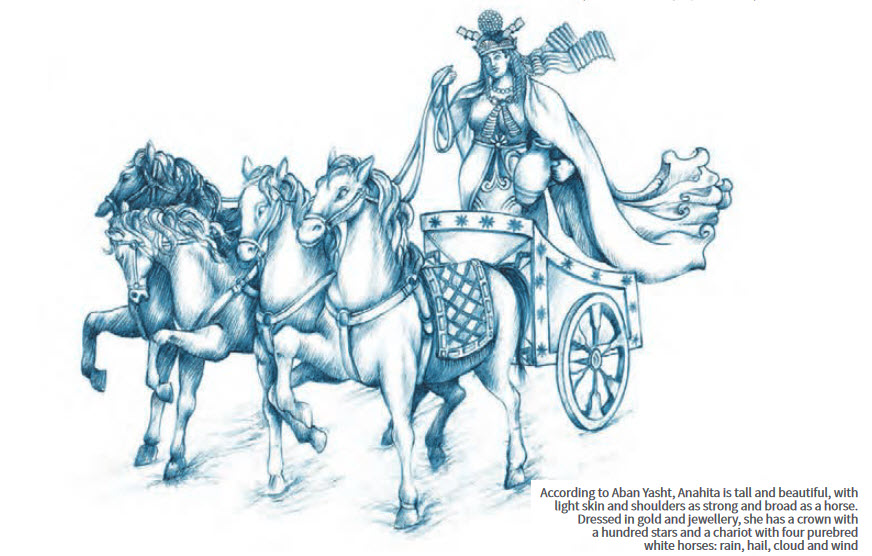 |
But since there were now mountains and valleys on the earth, from the deluge, streams, currents, and rivers came into being - fresh waters that could sustain and keep life. And, since each heavenly creation should have a guardian, Ahura Mazda made Anahita the keeper of freshwaters and streams. Anahita: Deeds and Duties Anahita, in the Avestan language, means clean, without pollution, pure. In the Avesta, the sacred book of the Zoroastrians, a long and beautiful hymn, 'Aban Yasht, is dedicated to her. She is called 'the owner of a thousand lakes and a thousand rivers, each as long as the 40-day Journey of a fast horse rider. She cleans all polluted and Impure waters, even the seed of men and wombs of women. Such is the glory of Anahita that Ahura Mazda himself regards her as one of his most powerful companions.
In 'Aban Yasht', a detailed description of Anahita's appearance is provided: she is tall and beautiful, with light skin and shoulders as strong and broad as a horse. Dressed in gold and jewelry, she wears a crown made of a hundred stars and has a chariot led by four purebred white steeds: rain, hail, cloud, and wind. Her mansions, which are found by lakes and rivers, are decorated with a thousand shining windows and a thousand well-sculpted columns; each mansion is elevated on a thousand pillars.
So great is the might of Anahita that all of ancient Iran's mythical figures and heroes pay tribute to her In order that their wishes be answered; each brings to her a hundred horses, a thousand cattle and ten thousand sheep. The first among them is Ahura Mazda himself. He prays to Anahita to encourage Zoroaster to become his prophet. Hushang, the first king In Persian mythology to bring law and order to the world, prays to Anahita to be able to vanquish his enemies. Jamshid, the most glorious mythological king of all, asks Anahita to give him the power to banish death and suffering from the world.
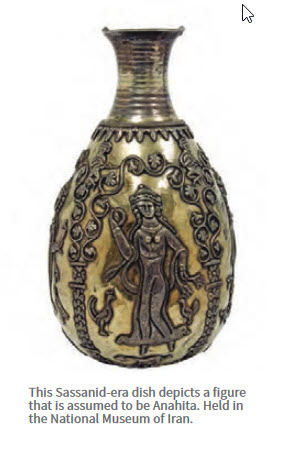 |
Even Aží Dahaka or Zahhak - the evil creation of Ahriman and the murderer of Jamshid - prays to Anahita so that he can destroy Ahura Mazda's entire universe. But, since he is malicious, Anahita never answers his prayers. By contrast, Fereydun, the hero who wants to avenge Jamshid's death, prays for the defeat of AŽI Dahaka, and his wish is granted. Garshasp, the legendary hero and warrior, prays to become the world's most powerful man and to be able to kill dragons and defeat all of his evil enemies. Afrasiab, a villain that prays to Anahita, is a king of Turan and a sworn enemy of Iran. He prays to seize the glory of the Iranian kings but, just like AŽI Dahāka, he is unsuccessful.
The righteous king Kay Khosrow, who is Persian mythology's most utopian leader, prays to Anahita to be victorious in his battle against Afrasiab and avenge the murder of his father, Prince Siavash. The warriors of both Iran and Turan pray to and worship Anahita but since the Iranians are fighting for good over evil they emerge victorious. As you can see, everyone worships Anahita, but she only answers those who practice good thoughts, good words, and good deeds, which are the three principles of Zoroastrianism. Anahita: Origins and Place In History According to most researchers, Anahita's origins are a mixture of old Indo-Iranian mythology and that of the ancient civilization of Mesopotamia. In the Vedas, the sacred body of Hindu literature written in Vedic Sanskrit, the goddess of rivers and streams is called Saraswati. Although her functions and duties do not clearly match those of Anahita, she is the closest equivalent figure.
On the other hand, in ancient Mesopotamia, there was another goddess - named Inanna by Sumerians and, later, Ishtar by the Akkadians, Babylonians, and Assyrians - who was also connected to water and streams. But Ishtar was also the goddess of love, a trait not associated with Anahita. Ishtar's association with love may have given rise to the cult of Aphrodite In ancient Greece and Venus in ancient Rome.
Interestingly, the Avesta offers a clear physical description of Anahita. This is exceptional because ancient Iranians, unlike most ancient Greeks, Indians, Egyptians, and Mesopotamians, did not usually depict their gods and goddesses in physical form and very few representations of their deities are extant. This may be another clue that indicates Anahita's origins in the Mesopotamian goddess Ishtar.
In search of Anahita
Anahita, which in the Avestan language means clean, without pollution, pure, originates from a mixture of old Indo-Iranian mythology and that of the ancient civilization of Mesopotamia. She is called 'the owner of a thousand lakes and a thousand rivers, each as long as the 40-day journey of a fast horse rider! She cleans all polluted and impure waters, even the seed of men and wombs of women. Such is the glory of Anahita that Ahura Mazda himself regards her as one of his most powerful companions. Here we trace temples dedicated to Anahita in Iran and some equivalent figures in other ancient civilizations.
 |
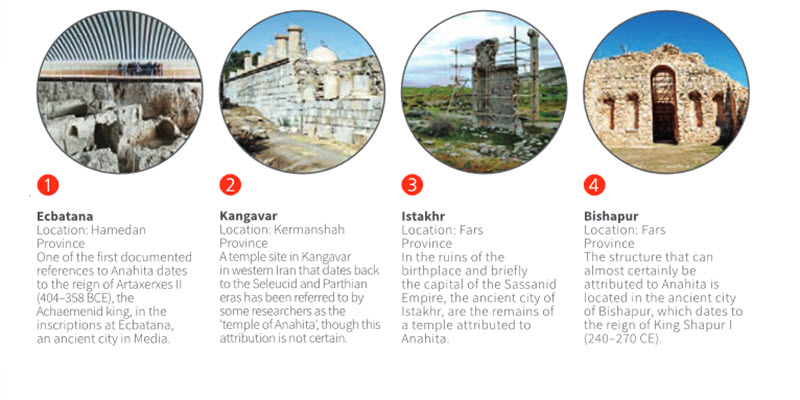 |
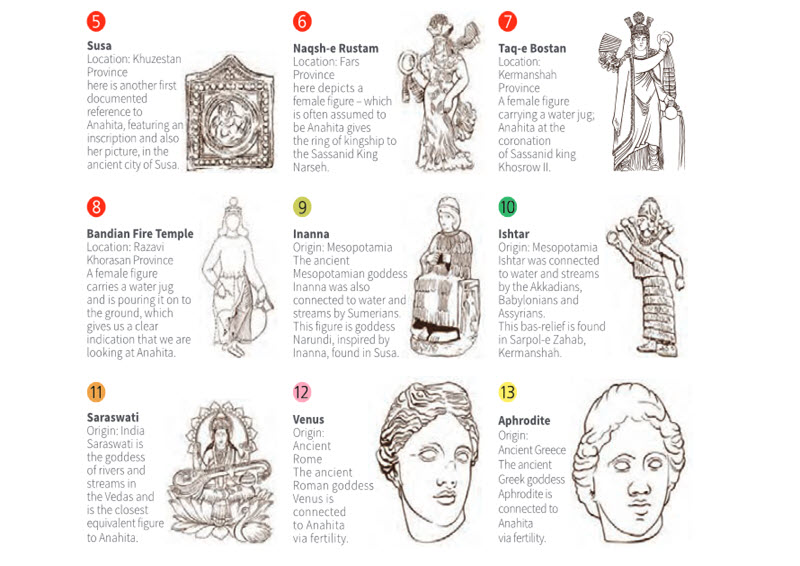 |
Greek historians mention the existence of temples dedicated to Anahita in the Persian Empire and speak of "Anaitis' who is possibly one and the same Iranian goddess. Herodotus also mentions that Persians respect streams and waters and do their best not to pollute them, a clear reference to their obligation to keep waters pure and thereby venerate Anahita. Numerous female figurines from the Achaemenid and Parthian periods that can be connected to the goddess have been found, though some represent fertility - hence reminding us of the mixed origins of Anahita and her composite role in ancient Iran.
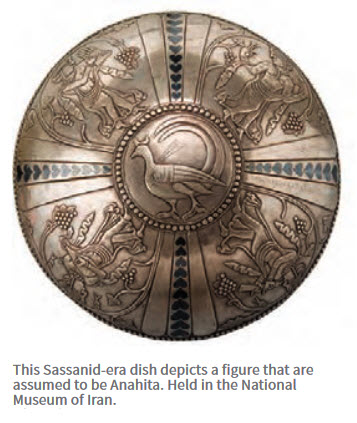 |
Early Zoroastrianism and Places of Veneration Concerning Indo-Iranian religions, it is known that Zoroaster heavily reformed earlier religious and cultic beliefs In placing Ahura Mazda as the sole creator of the world above all other deities. Immediately after Ahura Mazda in the hierarchy are six deities - the ameshaspandn (amesha spenta) - and then the izadan (yazatas). These delties are sometimes referred to as archangels and angels in Western literature.
At least two of these yazatas - Mithra and Anahita - are almost as powerful as Ahura Mazda in the Avesta. This indicates that these two deities were perhaps worshipped separately before the Zoroastrian reforms and, even after Zoroaster, kept their original position in the new religion. Even when the archangel Haurvatator
Khordad was assigned to guard the waters by the new religion, he was never fully able to usurp the ancient Anahita and the former goddess remained unchallenged.
We know that the Avestan texts are ancient but their exact date of creation is unknown because they were most likely transmitted orally from one generation to the next and most probably were finally compiled during the Sassanid period. Another problem is that the Avestan texts do not have a uniform structure and are from different periods and places. In this sense, the Avesta is a true compilation. But, for example, the hymn 'Aban Yasht' is believed to have taken shape probably during the Achaemenid period.
The first documented reference to Anahita dates to the reign of Artaxerxes II (404-358 BCE), the Achaemenid king, in the inscriptions at Ecbatana and Susa:
"May Ahura Mazda, Anahita, and Mithra protect me and what I have built from destruction and evil.' A temple site in Kangavar in western Iran that dates back to the Seleucid and Parthian eras has been referred to by some researchers as the temple of AnahIta', though this attribution is not certain. A major phase of the history of the worship of Anahita comes to light during the reign of the Sassanid Empire. According to early Muslim historians, such as Abu Ja'far Muhammad ibn Jarir al-Tabari, Sassanids were the priests and guardians of the fire temples of Anahita before they came to the throne. In the ruins of the birthplace of the Sassanid Empire, the ancient city of Istakhr in Fars Province, are the remains of a temple that could be the same one mentioned in those al-Tabari texts. In the inscriptions of Kartir, the 3rd-century mobed (high-priest) of at least three Sassanid emperors, it is stated that King Bahram II (274-293 CE) made Kartir the warden of the temples of Adur-Anahid and Anahid-e Banug (fire of Anahita and Lady Anahita) in Istakhr to him, which seems to confirm the statements of later Muslim historians.
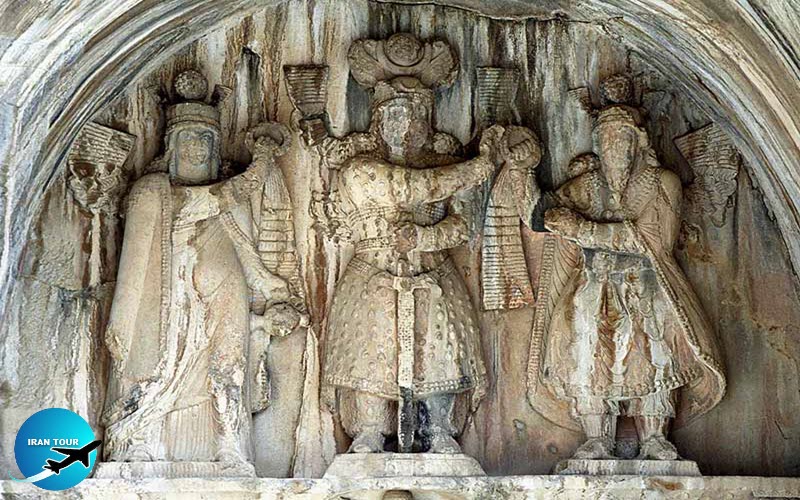 |
| The Taq-e Bostan complex features a series of large rock reliefs dating from the Sassanid Empire. This rock relief is considered to represent khosrowII flanked by Ahura Mazda and Anahita. |
The structure that can almost certainly be attributed to Anahita is located in the ancient city of Bishapur, which dates to the reign of King Shapur 1 (240-270 CE): close to a magnificent fire temple, a four-cornered structure is surrounded by waterways on all sides. These waterways come together at the center of the temple, forming a shallow pool. Decorations reminiscent of the structures in Persepolis show the Sassanids' desire to portray themselves as the heirs to Achaemenids. The existence of these waterways and pool clearly show a connection between the temple and Anahita.
Rock Carvings In Anahita's Image Along with Mithra and Ahura Mazda, Anahita is among only a handful of deities depicted in ancient Iranian art during the Sassanid period in at least three places: Naqsh-e Rustam, Taq-e Bostan, and the Indian Fire Temple. Naqsh-e Rustam necropolis in Fars Province comprises bas-relief rock carvings depicting the coronation of King Narseh (293-302 CE), son of Shapur I. The ho king, unlike other Sassanid kings, is taking the ring of kingship from a female figure - not Ahura Mazda as is often the case. The female deity is often assumed to be Anahita.
The other two scenes, which depict Anahita are at Taq-e Bostan in Kermanshah in the west-the coronation of Khosrow II (590-628 CE) - and at the Bandian Fire Temple complex in Dargaz in the northeast, which probably dates to the reign of Bahram V also known as Bahram Gor (420-438 CE) and his victory over the Hephthalites. In both cases, a female figure carries a water jug and is pouring it to the ground, which gives us a clear indication that we are looking at Anahita.
Anahita still plays an important role in the life of Zoroastrians and, even after all these years, her legacy of keeping Iran's waters pure and untainted mirrors contemporary environmental concerns. Modern Iranians name their daughters Nahid, which is the modern Persian form of Anahita, and pour water behind relatives who are about to travel, as a sign of good luck and to keep them safe. As our title states, we hope that the waters may run pure for eternity! And, as ancient Iranians used to say, 'may it be, even more, may it be!
- Details
- Category: IRAN Blog